Release Date :
Reference Number :
2013-052
Two-thirds of the population 15 years and over are in the labor force
The July 2012 LFS registered a labor force participation rate (LFPR) of 64.0 percent. The size of the labor force in July 2012 was approximately 40.4 million out of the estimated 63.1 million population 15 years old and over. The LFPR was highest in Northern Mindanao at 70.3 percent and lowest in Autonomous Region in Muslim Mindanao (ARMM) at 54.6 percent (Table 1 and Table 2).
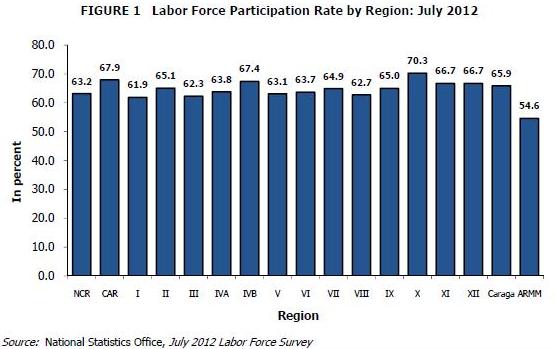
Employment rate is 93.0 percent
The employment rate estimated for July 2012 was 93.0 percent which is not significantly different from the July 2011 rate of 92.9 percent. This implies that nine in every 10 persons in the labor force were employed.
The National Capital Region (NCR) recorded the lowest employment rate at 90.1 percent. Other regions with employment rates lower than the national value were Central Visayas (92.9), Ilocos Region (91.4%), Central Luzon (90.8%) and CALABARZON (90.6%). Meanwhile, the regions with employment rate higher than 95 percent were Cagayan Valley (96.8%), MIMAROPA and Zamboanga Peninsula (95.9%), Eastern Visayas and SOCCSKSARGEN (95.7%), ARMM (95.6), and Cordillera Administrative Region (95.1%) (Table 1).

Three in five of the employed population are males
Three in five (60.4%) of the employed population in July 2012 were males.
One in four (26.5%) of employed persons was in the age group 25 to 34 years. The 35 to 44 year age group comprised the second largest group, making up 23.0 percent of the total employed, followed by the 15 to 24 age group with 18.9 percent (Table 3).
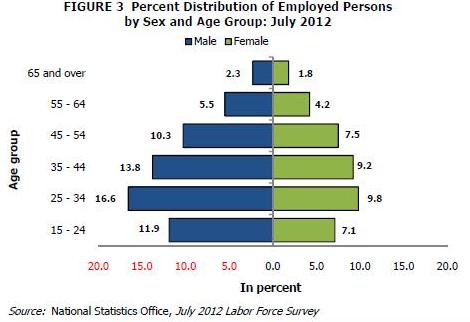
More than half of the total employed are in the services sector
The estimated number of employed in July 2012 was 37.6 million. More than half (53.3%) of this number worked in the services sector with those employed in wholesale and retail trade; repair of motor vehicles, motorcycles, comprising the largest sub-sector (17.8% of the total employed). Workers in agriculture sector accounted for 31.0 percent of the total employed, with workers in the agriculture, hunting and forestry making up the largest sub-sector (27.3% of the total employed). Only 15.7 percent of the total employed were in the industry sector (Table 4).
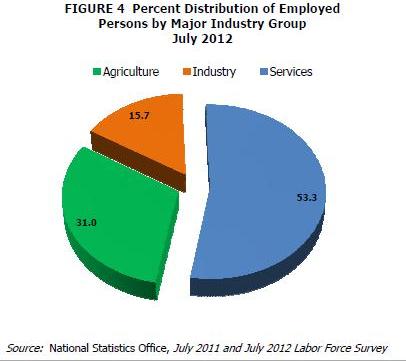
One-third of employed population are laborers and unskilled workers
Among the various occupation groups, laborers and unskilled workers comprised the largest proportion (33.9%) of the total employed population. Officials of the government and special interest organizations, corporate executives, managers, managing proprietors and supervisors were the second largest group, accounting for 14.6 percent of the total employed population (Table 5).
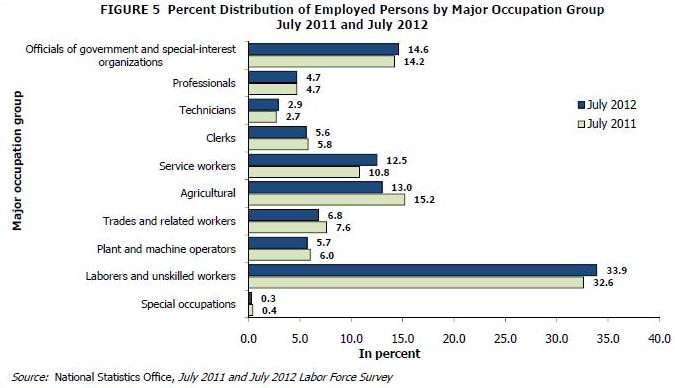
More than half of total employed are wage and salary workers
Employed persons fall into any of these three categories: wage and salary workers, self-employed without any paid employee, employer in own family-operated farm or business and unpaid family workers. Wage and salary workers are those who work for private households, private establishments, government and government-controlled corporations and those who work with pay in own family-operated farm or business. More than half (60.1%) of the employed persons were wage and salary workers, 26.4 percent were self-employed, 3.9 percent were employer in own family-operated farm or business and 9.7 percent were unpaid family workers. Among the wage and salary workers, those working for private establishments comprised the largest proportion (46.2% of the total employed). Government workers and those working for the government-controlled corporations comprised 8.0 percent of the total employed, while workers in private households, 5.6 percent, (Table 6).
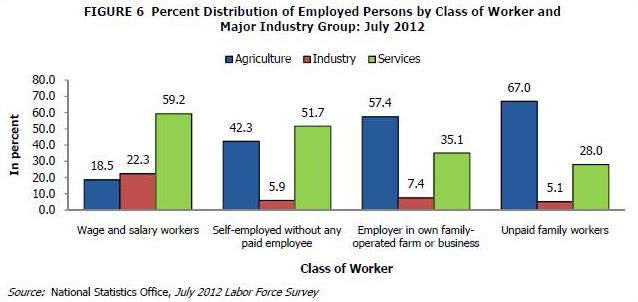
Among the self-employed workers, those in the services (51.7% of the self-employed) and the agriculture (42.3%) sectors made up the largest percentage. Among the unpaid family workers, about seven in ten were in the agriculture sector (67.0% of the unpaid family workers) (Table 7).
Two-thirds of employed persons work full-time
Employed persons are classified as either full-time or part-time workers. Full-time workers are those who work for 40 hours or more while part-time workers work for less than 40 hours. Around 65 percent of the total employed persons in July 2012 were full-time workers with those working for 40 to 48 hours making up a larger proportion (41.2% of the total employed) than those working for more than 48 hours (24.3%). Part-time workers comprised 33.8 percent of the total employed (Table 8).
One in every five employed workers wants more hours of work
Employed persons who express the desire to have additional hours of work in their present job or to have additional job, or to have a new job with longer working hours are considered underemployed. The number of underemployed persons was estimated at 8.6 million in July 2012. This represented 22.8 percent of the total employed. Last year’s estimate was 7.1 million.
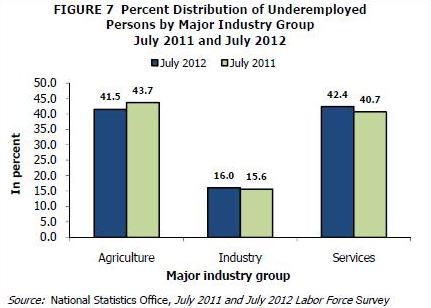
Nearly the same proportion of the underemployed, about 42 percent were in the agriculture (41.5%) and services (42.4%) sectors, while those in the industry sector comprised 16.0 percent. Of the underemployed, those considered as visibly underemployed, or had been working for less than 40 hours a week, accounted for 53.6 percent (Table 9).
Unemployment rate is 7.0 percent
The unemployment rate in July 2012 was estimated at 7.0 percent. Among the regions, the highest unemployment rate was recorded in the NCR at 9.9 percent. The next highest rates were posted in CALABARZON (9.4%) and Central Luzon (9.2%) (Table 1).
More than half (51.1%) of the unemployed were in the age group 15 to 24 years (Table 3).

Across educational groups, among the unemployed, high school graduates comprised one-third (33.3%), while the college graduates, 19.2 percent (Table 10).
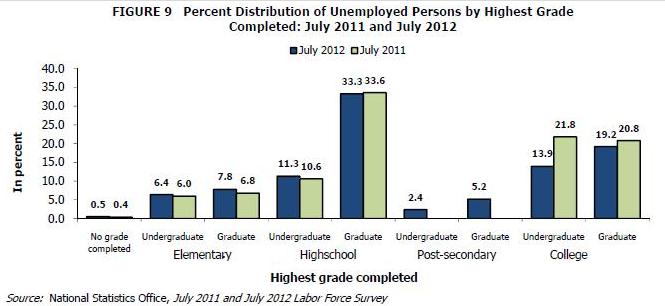
Seven in every ten persons not in the labor force are females
The number of persons not in the labor force like housewives, students, persons with disability, and retirees was approximately 22.7 million in July 2012. This number comprised 36.0 percent of the total population 15 years old and over. Seven in every ten (69.1%) persons who were not in the labor force were females (Table 3).

By age group, the majority of those who were not in the labor force were below 35 years of age; that is, 45.8 percent were 15 to 24 years old and 16.8 percent were 25 to 34 years old (Table 3).
SUMMARY
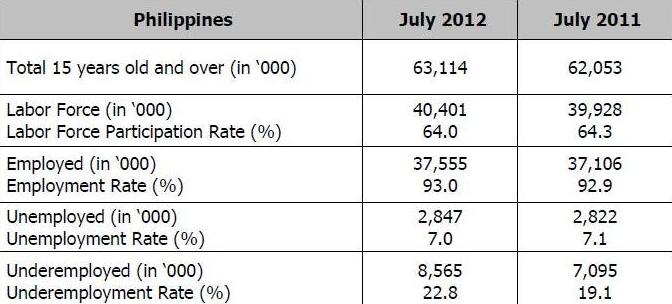
ï¶ The number of persons in the labor force, or those who are either employed or unemployed was estimated at 40.4 million in July 2012, resulting to a labor force participation rate of 64.0 percent.
ï¶ The national employment rate was recorded at 93.0 percent in July this year.
 More than half (53.3%) of the employed persons worked in the services sector, 31.0 percent in the agricultural sector and 15.7 percent in the industry sector.
 One-third (33.9%) of the employed population were laborers and skilled workers.
 Wage and salary workers accounted for more than one-half (60.1%) of the total employed persons.
ï¶ Underemployment rate was estimated at 22.8 percent in July 2012
 Majority (53.6%) of the total underemployed were reported to have been working for less than 40 hours a week.
ï¶ The unemployment rate was estimated at 7.0 percent in July 2012.
 Among regions, the highest unemployment rate was recorded in the National Capital Region at 9.9 percent.
 Unemployed college graduates accounted for 19.2 percent.
Technical Notes
This Labor Force Survey (LFS) is a nationwide survey conducted quarterly by the National Statistics Office (NSO). For this release, the data being presented are based on the final results of the July 2012 round of the LFS.
The reference period used in the survey is the past seven days preceding the date of visit of the enumerator. The number of sample households was 51,000.
The concepts and definitions used in the survey can be found in the regular NSO-Integrated Survey of Households Bulletins. Some are given below:
a. Labor Force – refers to the population 15 years old and over who contribute to the production of goods and services in the country. It comprises the employed and unemployed.
b. Employed – refers to persons in the labor force who are reported either as at work or with a job or business although not at work. Persons at work are those who did some work, even for an hour during the reference period.
c. Unemployed – Starting April 2005, the new unemployment definition was adopted per NSCB Resolution Number 15 dated October 20, 2004. As indicated in the said resolution, the unemployed include all persons who are 15 years and over as of their last birthday and are reported as: (1) without work and currently available for work and seeking work; or (2) without work and currently available for work but not seeking work for the following reasons:
c.1 Tired believed no work available
c.2 Awaiting results of previous application
c.3 Temporary illness/disability
c.4 Bad weather
c.5 Waiting for rehire/job recall
d. Underemployed – refers to the employed persons who express the desire to have additional hours of work in their present job or an additional job, or have a new job with longer working hours.
e. Labor Force Participation Rate (LFPR) – proportion of total labor force to the total household population 15 years and over.
f. Employment Rate – proportion of employed persons to the total labor force.
g. Unemployment Rate – proportion of unemployed persons to the total labor force.
h. Underemployment Rate – proportion of underemployed persons to total employed persons.
Starting with the July 2003 round, the LFS used the 2003 Master Sample Design. Using this master sample design, the number of sample households is around 50,000 households.
The province of Basilan is included in the Autonomous Region in Muslim Mindanao while Isabela City in Basilan is placed under Region IX - Zamboanga Peninsula in accordance with Executive Order No. 36.
Starting with the January 2007 LFS round, the population projections based on the 2000 Census of Population and Housing (CPH) has been adopted to generate the labor force statistics. This is in compliance with NSCB Resolution No. 1 series of 2005 entitled Adoption of the Methodology Used in Generating the 2000 Census of Population and Housing-Based National Population Projections.
Starting with the January 2010 LFS round, a revised nomenclature on class of worker was adopted. In the reports on previous rounds of LFS, particularly in the statistical tables on employed persons by class of worker, the self-employed and employer in own family-operated farm or business were classified as own-account workers. For the same statistical table in this report, the term own-account worker no longer appears as heading for employer and self-employed to avoid confusion. In the International Classification of Status in Employment (ICSE), the term “own-account worker” is synonymous to the category “self-employed” in the Philippines LFS.
Starting January 2012 LFS, the codes for industry adopted the 2009 Philippines Standard industrial Classification (PSIC). Prior to this, codes for industry used the 1994 PSIC.
The 1992 four-digit code for Philippine Standard Occupational Classification (PSOC) was used in classifying occupation.
Starting in the January 2012 LFS, more detailed categories for highest grade completed used in the 2010 Census of Population and Housing (CPH) were also adopted.
Starting in the January 2012 LFS, a question on whether the household member is a graduate of a technical vocational course was asked for each person 15 years old or older.
